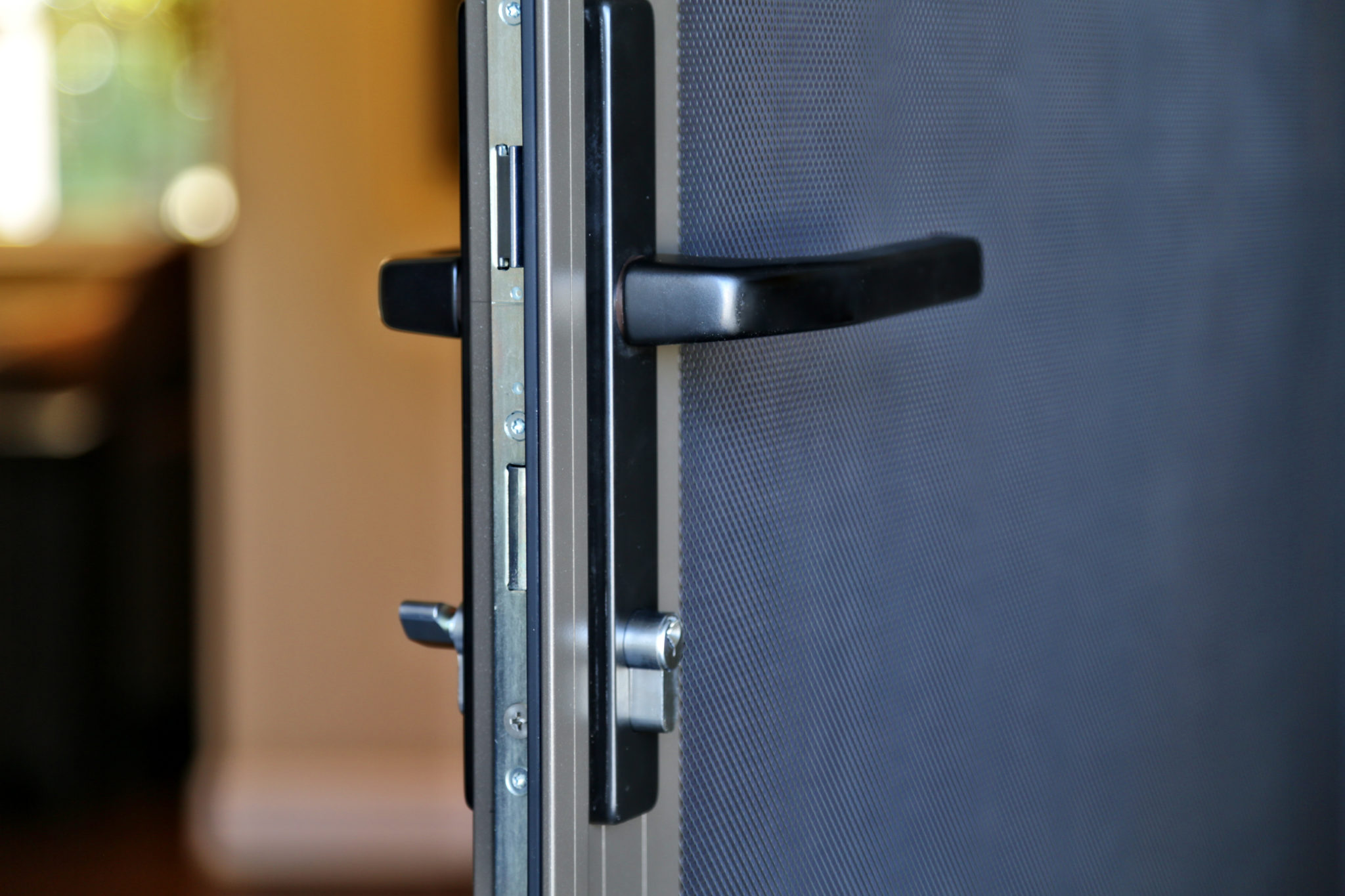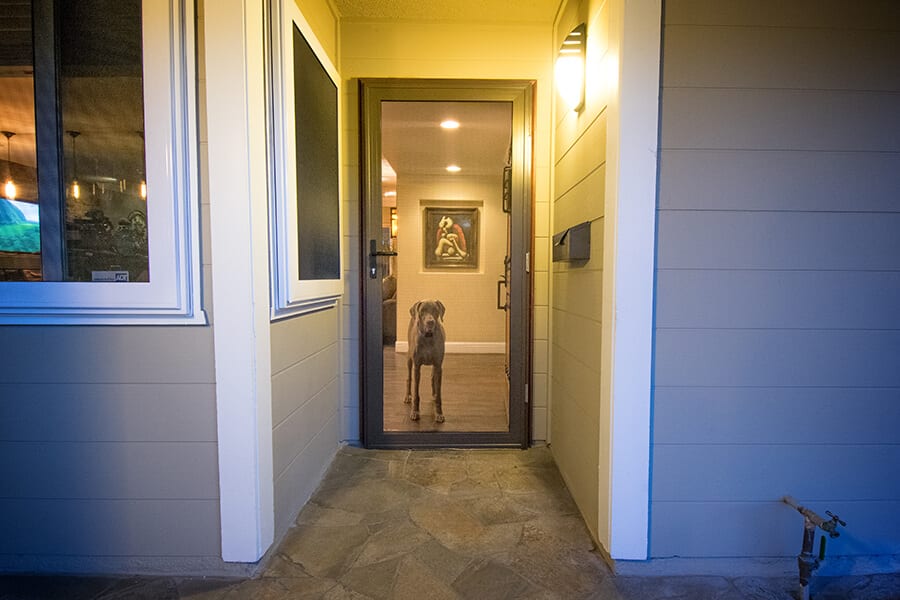Security screen doors and windows are a great way to add an extra barrier against forced entry by home invaders. The tightly-woven stainless steel mesh resists knives, crowbars, and other tools commonly used by burglars to commit break-ins.
However, this fine mesh can also accumulate buildups of dirt. These buildups can inhibit visibility and make your screens look untidy. They can also potentially hurt the durability of the screens in the long run.

Routinely cleaning security screens will help ensure that they continue to provide that extra layer of security to keep threats outside and buy first responders more time. Keep reading to learn how to clean screen doors and windows, so they stay clean and in optimal shape.
Step by Step: The Best Way to Clean Screens
How to Clean Screen Doors and Windows in 5 Easy Steps
- Vacuum
- Make cleaning solution
- Wash
- Rinse and dry
- Clean tracks and frame
1) Vacuum the Screen
Use a light handheld vacuum or a vacuum with an extendable hose attachment.
Turn the vacuum on and run it over the front of the screen to suck up loose dirt, dust, and debris.
Start at one side and vacuum from top to bottom, then work your way to the other side with overlapping strokes to ensure you don’t miss any parts of the door screen.
2) Make a Cleaning Solution
Fill a bucket or another container with about 1/2 a gallon of water.
Pour in 1/4 cup of all-purpose cleaner.
Mix the water and all-purpose cleaner to create your screen door cleaning solution.
3) Wash the Security Screen
Dip a clean sponge or microfiber cloth into the cleaning solution, then wring out the excess liquid so it isn’t dripping.
Wipe the entire screen down, applying gentle pressure to loosen any stuck-on grime.
Rinse out the sponge or cloth and repeat the process until the screen looks clean.
4) Rinse and Dry the Screen
Turn on your garden hose to low pressure and spray down the entire screen thoroughly until all the cleaning solution is gone.
Make sure to do this as soon as you finish washing the screen so that the cleaning solution doesn’t have time to dry and leave a soapy residue behind.
Pat the screen dry with a clean towel after you rinse it to soak up the excess water, then let it air dry.
5) Clean the Tracks and Frame
Open up your security screen door so you can access the tracks and frame.
Wipe down all the grooves in the tracks and frame using the same cleaning solution and sponge or microfiber cloth, but avoid the locking mechanism.
Use a clean, dry towel to wipe up the excess water, then let everything air dry.

Tips for Cleaning Screens:
- Blast stubborn dirt and grime away with an air compressor or use a stiff-bristled dust brush to brush it away.
- Don’t use sandpaper or other abrasive materials that can cause surface scratches on your screens.
- Put down some old towels or rags on the window sills and floor below the screens to absorb excess water and make cleaning up easier.
- You can purchase a special window screen cleaner, which is a roller brush that you can use to wash your security screens instead of a sponge or microfiber cloth.
- If the locking mechanism ever seems stiff after cleaning your screen door, apply graphite powder to the locks.
- Never use WD-40 or oil on your security screen door locks as they attract dust and dirt.
How Often Should You Clean Screen Doors and Windows?
Screen Cleaning Frequency Depends on Where You Live
The environment you live in is the main factor that affects how quickly your security screens get dirty:
- In highly urban environments, or near the coast, you should clean screen doors every three months or so.
- In less urban and rural areas, you should be fine if you clean your screens once every six months.
- If you live in a highly industrialized or polluted area, or right next to the ocean, you may need to clean your screens up to twice a month.
Security screens can also accumulate more grime during particular seasons. For example, at certain times of the year, there are higher concentrations of pollen in the air, which can easily float into your screens and get trapped.

If you get seasonal buildups in your screens, it’s best to clean them at the beginning and end of the season. No matter what conditions you live in, the more frequently you clean screen doors and windows, the easier it will be to get rid of dirt and debris.

If you notice that it takes you a long time to clean your security screens, try to do it more often, so the job takes less time and effort. You’ll appreciate the improved visibility and appearance, and your screens will stay in optimal shape and last longer!
Benefits of Screen Door Cleaning
Why You Should Clean Screens Regularly
The most important reason to keep your security screens clean is to maintain their optimal performance so they continue to serve their principal purpose of protecting your home.

However, there are additional benefits to having clean security screens that you might not initially think of.
Besides providing an extra layer of security on top of your doors and windows, security screens also act as filters that help block outside dust, dirt, and pollen from entering your home when you open your doors or windows.
Since security screens have this filtering property, they can quickly build up dusty deposits if you tend to leave your doors and windows open for airflow often. As the screens accumulate these buildups, the airflow they allow into your home is reduced.
The more frequently you clean your security screens, the more airflow you will be able to enjoy in your home when you want to let some fresh air in.

Another benefit of maintaining clean screen doors is keeping up the presentation of your property. Front doors are often the focal point of a home, so a dusty, dirty looking security screen covering up your door greatly detracts your home’s curb appeal.
A well-maintained security screen will keep your entryway looking classy all year long!






